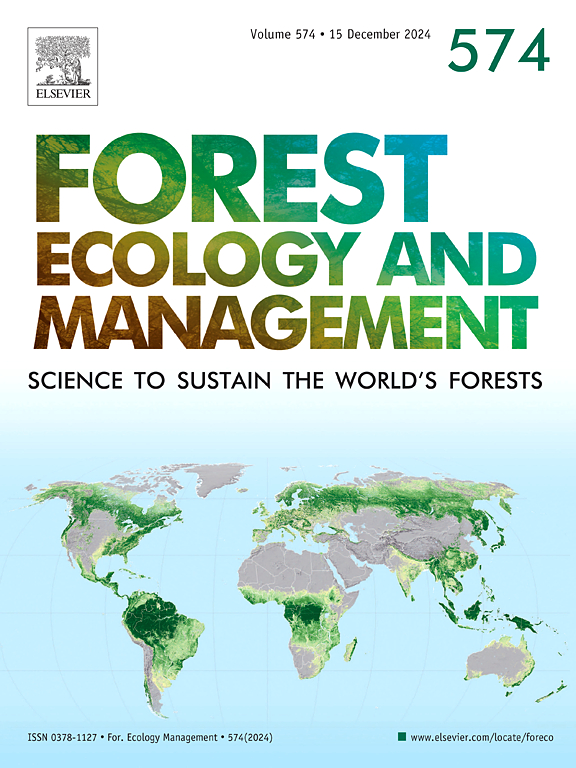干旱是否调节地中海山区松栎林物种混合效应对干旱生长的响应?
IF 3.7
2区 农林科学
Q1 FORESTRY
引用次数: 0
摘要
森林管理面临着地中海生态系统适应更加频繁和严重的极端干旱的重大挑战。树种混合被视为提高森林长期恢复力的关键策略。然而,对树木对干旱反应的积极影响的证据是有限的,并且取决于环境。在此,我们分析了物种混合对树木生长对极端干旱事件响应的影响是否受到场地干旱和干旱强度的调节。为此,我们选择了野生柏混交林和单株林分。和西班牙中部山区沿环境梯度的西尔韦stris L.,并使用树木年代学方法量化极端干旱下的生长稳定性。混交林中栎树表现出较强的生长恢复力和恢复力,而松树表现出较强的抗性和较低的恢复力。物种混合对松木抗旱性的影响与立地干旱性无关,但在更干旱的立地,物种混合对松木抗旱性有更积极的影响。这两个物种在抗性和恢复之间表现出强烈的权衡关系,但恢复不能弥补松树的低抗性,这表明改善干旱影响的重要性。我们的研究结果强调,在干旱易发森林中,多样化的单种林分和不同的功能物种可以提高生长稳定性。这项研究还可以帮助森林管理者优先考虑那些多样化的单一林分可以产生更多积极结果的地区。本文章由计算机程序翻译,如有差异,请以英文原文为准。
Does aridity modulate species mixing effects on growth response to drought in pine-oak forests in Mediterranean mountains?
Forest management faces important challenges for the adaptation of Mediterranean ecosystems to more frequent and severe extreme droughts. Tree species mixing is seen as a key strategy to enhance long-term forest resilience. However, the evidence of positive effects on tree response to droughts is limited and context dependent. Here, we analyzed whether the effect of species mixing on tree growth response to extreme drought events was modulated by site aridity and drought intensity. For this, we selected mixed and monospecific stands of Quercus pyrenaica Willd. and Pinus sylvestris L. along an environmental gradient in mountains in central Spain and quantified growth stability to extreme droughts using dendrochronological methods. Oaks showed greater growth resilience and recovery in mixed than in monospecific stands, while pines showed greater resistance but lower recovery. The effect of species mixing was not related to site aridity, yet we found a trend toward more positive effects of admixture on pine resistance to drought in more arid sites. Both species showed a strong trade-off between resistance and recovery, but recovery cannot compensate for low resistance in pines pointing to the importance of ameliorating drought impacts. Our results emphasize that diversifying monospecific stands with functionally different species can enhance growth stability in drought prone forests. This study can also help forest managers to prioritize areas where diversifying monospecific stands could generate more positive outcomes.
求助全文
通过发布文献求助,成功后即可免费获取论文全文。
去求助
来源期刊

Forest Ecology and Management
农林科学-林学
CiteScore
7.50
自引率
10.80%
发文量
665
审稿时长
39 days
期刊介绍:
Forest Ecology and Management publishes scientific articles linking forest ecology with forest management, focusing on the application of biological, ecological and social knowledge to the management and conservation of plantations and natural forests. The scope of the journal includes all forest ecosystems of the world.
A peer-review process ensures the quality and international interest of the manuscripts accepted for publication. The journal encourages communication between scientists in disparate fields who share a common interest in ecology and forest management, bridging the gap between research workers and forest managers.
We encourage submission of papers that will have the strongest interest and value to the Journal''s international readership. Some key features of papers with strong interest include:
1. Clear connections between the ecology and management of forests;
2. Novel ideas or approaches to important challenges in forest ecology and management;
3. Studies that address a population of interest beyond the scale of single research sites, Three key points in the design of forest experiments, Forest Ecology and Management 255 (2008) 2022-2023);
4. Review Articles on timely, important topics. Authors are welcome to contact one of the editors to discuss the suitability of a potential review manuscript.
The Journal encourages proposals for special issues examining important areas of forest ecology and management. Potential guest editors should contact any of the Editors to begin discussions about topics, potential papers, and other details.
 求助内容:
求助内容: 应助结果提醒方式:
应助结果提醒方式:


